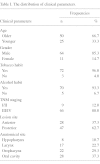HPV-16/18 detection does not affect the prognosis of head and neck squamous cell carcinoma in younger and older patients
- PMID: 22741024
- PMCID: PMC3362356
- DOI: 10.3892/ol.2012.588
HPV-16/18 detection does not affect the prognosis of head and neck squamous cell carcinoma in younger and older patients
Abstract
Recently, high-risk human papillomavirus (HPV) has emerged as a possible agent associated with head and neck squamous cell carcinoma (HNSCC) in younger patients. Therefore, the purpose of the present study was to assess the effect of age on the distribution of HPV-16/18 in HNSCC, together with the impact of the virus on patient prognosis. A longitudinal prospective study was used adjusted for age, gender, TNM staging, smoking status and alcohol consumption. HPV was detected by PCR with consensus primers. Results showed there was no difference in the frequency of HPV-16/18 positivity when younger patients were compared to the older patients. No association was found among high-risk HPV positivity, gender, smoking habit and anatomical site. High-risk HPV was associated with advanced TNM in bivariate analyses; however, it did not impact on survival. Only TNM staging was associated with risk of mortality. Our study supports the theory that age does not affect the presence of HPV-16/18 in HNSCC and has no impact on patient prognosis. The incidence of HNSCC among patients under the age of 45 years is reportedly on the increase worldwide. The factors associated with HNSCC in younger adults are not well established. Findings of this study indicate that HPV-16/18 may not play a role in HNSCC patients under the age of 45 years.
Figures




Similar articles
-
Detection of Human Papilloma Virus and Risk Factors among Patients with Head and Neck Squamous Cell Carcinoma Attending a Tertiary Referral Centre in South India.Asian Pac J Cancer Prev. 2018 May 26;19(5):1325-1330. doi: 10.22034/APJCP.2018.19.5.1325. Asian Pac J Cancer Prev. 2018. PMID: 29802694 Free PMC article.
-
Classical risk factors, but not HPV status, predict survival after chemoradiotherapy in advanced head and neck cancer patients.J Cancer Res Clin Oncol. 2016 Oct;142(10):2185-96. doi: 10.1007/s00432-016-2203-7. Epub 2016 Jul 1. J Cancer Res Clin Oncol. 2016. PMID: 27370781 Free PMC article.
-
Human papillomavirus status in young patients with head and neck squamous cell carcinoma.Int J Cancer. 2012 Apr 15;130(8):1806-12. doi: 10.1002/ijc.26195. Epub 2011 Aug 2. Int J Cancer. 2012. PMID: 21607949
-
HPV in Head and Neck Carcinomas: Different HPV Profiles in Oropharyngeal Carcinomas - Why?Acta Cytol. 2019;63(2):124-142. doi: 10.1159/000495727. Epub 2019 Mar 12. Acta Cytol. 2019. PMID: 30861518 Review.
-
The molecular mechanism of human papillomavirus-induced carcinogenesis in head and neck squamous cell carcinoma.Int J Clin Oncol. 2016 Oct;21(5):819-826. doi: 10.1007/s10147-016-1005-x. Epub 2016 Jun 23. Int J Clin Oncol. 2016. PMID: 27339270 Review.
Cited by
-
[Skin diseases in geriatric patients. Epidemiologic data].Hautarzt. 2012 Dec;63(12):938-46. doi: 10.1007/s00105-012-2466-0. Hautarzt. 2012. PMID: 23247643 Review. German.
-
The role of human papillomavirus in oral squamous cell carcinoma: myth and reality.Oral Maxillofac Surg. 2014 Jun;18(2):165-72. doi: 10.1007/s10006-012-0383-0. Epub 2012 Dec 16. Oral Maxillofac Surg. 2014. PMID: 23242943
-
Evaluation of the Prevalence Rate and the Prognostic Effect of Human Papilloma Virus Infection in a Group of Patients With Oral Cavity Squamous Cell Carcinoma.Iran J Cancer Prev. 2016 Apr 25;9(3):e3998. doi: 10.17795/ijcp-3998. eCollection 2016 Jun. Iran J Cancer Prev. 2016. PMID: 27703640 Free PMC article.
-
Prevalence of oral and oropharyngeal human papillomavirus infection in Brazilian population studies: a systematic review.Braz J Otorhinolaryngol. 2015 Sep-Oct;81(5):554-67. doi: 10.1016/j.bjorl.2015.04.001. Epub 2015 Jul 21. Braz J Otorhinolaryngol. 2015. PMID: 26248966 Free PMC article.
-
Human papilloma virus (HPV) infection leads to the development of head and neck lesions but offers better prognosis in malignant Indian patients.Med Microbiol Immunol. 2017 Jun;206(3):267-276. doi: 10.1007/s00430-017-0502-5. Epub 2017 Mar 25. Med Microbiol Immunol. 2017. PMID: 28343330
References
-
- Parkin DM. Global cancer statistics in the year 2000. Lancet Oncol. 2001;2:533–543. - PubMed
-
- Parkin DM, Bray F, Ferlay J, Pisani P. Global cancer statistics, 2002. CA Cancer J Clin. 2005;55:74–108. - PubMed
-
- Argiris A, Eng C. Epidemiology, staging, and screening of head and neck cancer. Cancer Treat Res. 2003;114:15–60. - PubMed
-
- De Paula AM, Souza LR, Farias LC. et al. Analysis of 724 cases of primary head and neck squamous cell carcinoma (HNSCC) with a focus on young patients and p53 immunolocalization. Oral Oncol. 2009;45:777–782. - PubMed
-
- Garavello W, Spreafico R, Gaini RM. Oral tongue cancer in young patients: a matched analysis. Oral Oncol. 2007;43:894–897. - PubMed
LinkOut - more resources
Full Text Sources
